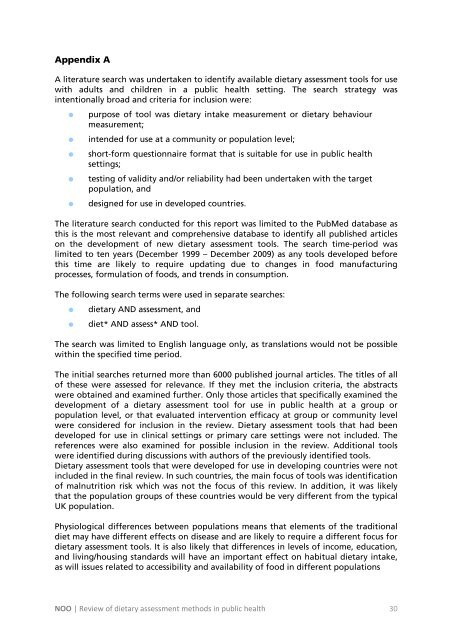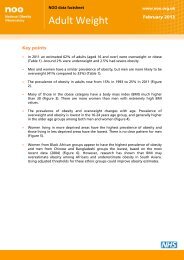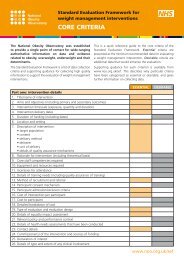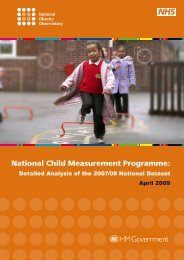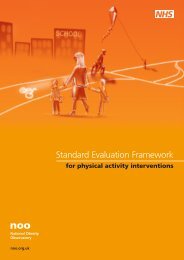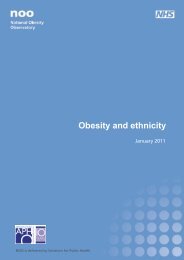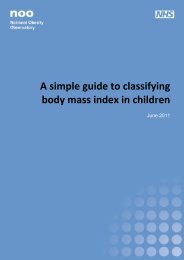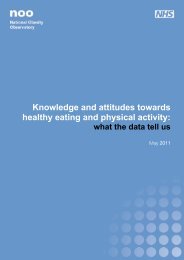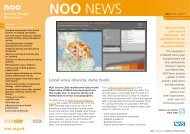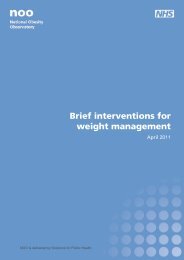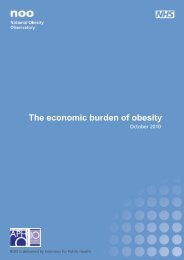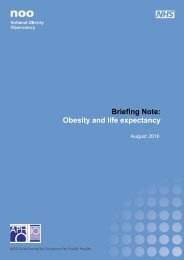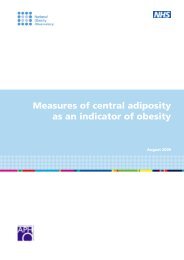Review of dietary assessment methods in public health - National ...
Review of dietary assessment methods in public health - National ...
Review of dietary assessment methods in public health - National ...
You also want an ePaper? Increase the reach of your titles
YUMPU automatically turns print PDFs into web optimized ePapers that Google loves.
Appendix AA literature search was undertaken to identify available <strong>dietary</strong> <strong>assessment</strong> tools for usewith adults and children <strong>in</strong> a <strong>public</strong> <strong>health</strong> sett<strong>in</strong>g. The search strategy was<strong>in</strong>tentionally broad and criteria for <strong>in</strong>clusion were:• purpose <strong>of</strong> tool was <strong>dietary</strong> <strong>in</strong>take measurement or <strong>dietary</strong> behaviourmeasurement;• <strong>in</strong>tended for use at a community or population level;• short-form questionnaire format that is suitable for use <strong>in</strong> <strong>public</strong> <strong>health</strong>sett<strong>in</strong>gs;• test<strong>in</strong>g <strong>of</strong> validity and/or reliability had been undertaken with the targetpopulation, and• designed for use <strong>in</strong> developed countries.The literature search conducted for this report was limited to the PubMed database asthis is the most relevant and comprehensive database to identify all published articleson the development <strong>of</strong> new <strong>dietary</strong> <strong>assessment</strong> tools. The search time-period waslimited to ten years (December 1999 – December 2009) as any tools developed beforethis time are likely to require updat<strong>in</strong>g due to changes <strong>in</strong> food manufactur<strong>in</strong>gprocesses, formulation <strong>of</strong> foods, and trends <strong>in</strong> consumption.The follow<strong>in</strong>g search terms were used <strong>in</strong> separate searches:• <strong>dietary</strong> AND <strong>assessment</strong>, and• diet* AND assess* AND tool.The search was limited to English language only, as translations would not be possiblewith<strong>in</strong> the specified time period.The <strong>in</strong>itial searches returned more than 6000 published journal articles. The titles <strong>of</strong> all<strong>of</strong> these were assessed for relevance. If they met the <strong>in</strong>clusion criteria, the abstractswere obta<strong>in</strong>ed and exam<strong>in</strong>ed further. Only those articles that specifically exam<strong>in</strong>ed thedevelopment <strong>of</strong> a <strong>dietary</strong> <strong>assessment</strong> tool for use <strong>in</strong> <strong>public</strong> <strong>health</strong> at a group orpopulation level, or that evaluated <strong>in</strong>tervention efficacy at group or community levelwere considered for <strong>in</strong>clusion <strong>in</strong> the review. Dietary <strong>assessment</strong> tools that had beendeveloped for use <strong>in</strong> cl<strong>in</strong>ical sett<strong>in</strong>gs or primary care sett<strong>in</strong>gs were not <strong>in</strong>cluded. Thereferences were also exam<strong>in</strong>ed for possible <strong>in</strong>clusion <strong>in</strong> the review. Additional toolswere identified dur<strong>in</strong>g discussions with authors <strong>of</strong> the previously identified tools.Dietary <strong>assessment</strong> tools that were developed for use <strong>in</strong> develop<strong>in</strong>g countries were not<strong>in</strong>cluded <strong>in</strong> the f<strong>in</strong>al review. In such countries, the ma<strong>in</strong> focus <strong>of</strong> tools was identification<strong>of</strong> malnutrition risk which was not the focus <strong>of</strong> this review. In addition, it was likelythat the population groups <strong>of</strong> these countries would be very different from the typicalUK population.Physiological differences between populations means that elements <strong>of</strong> the traditionaldiet may have different effects on disease and are likely to require a different focus for<strong>dietary</strong> <strong>assessment</strong> tools. It is also likely that differences <strong>in</strong> levels <strong>of</strong> <strong>in</strong>come, education,and liv<strong>in</strong>g/hous<strong>in</strong>g standards will have an important effect on habitual <strong>dietary</strong> <strong>in</strong>take,as will issues related to accessibility and availability <strong>of</strong> food <strong>in</strong> different populationsNOO | <strong>Review</strong> <strong>of</strong> <strong>dietary</strong> <strong>assessment</strong> <strong>methods</strong> <strong>in</strong> <strong>public</strong> <strong>health</strong> 30


